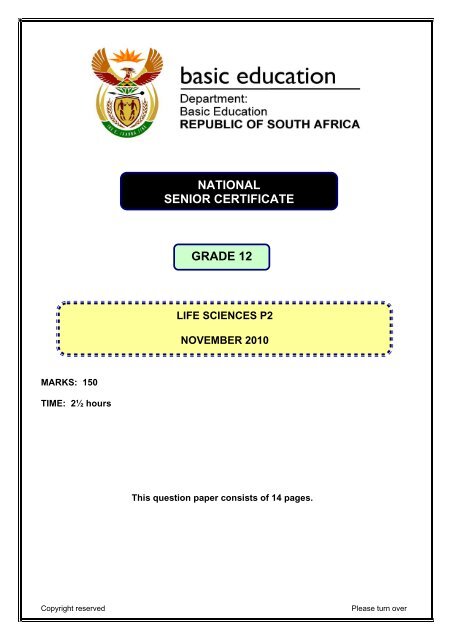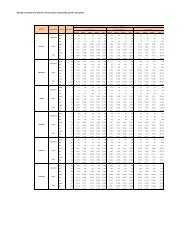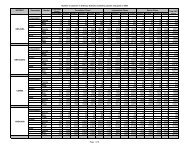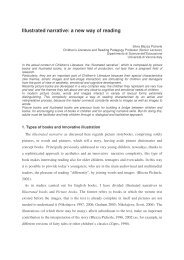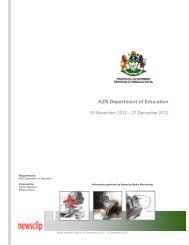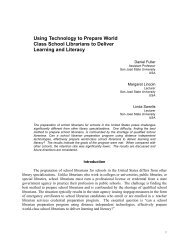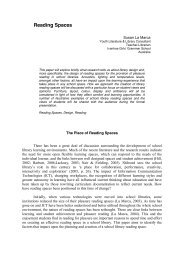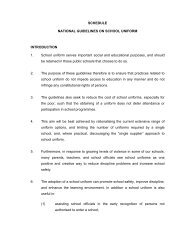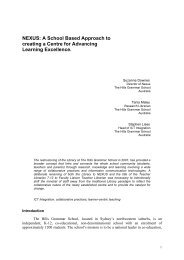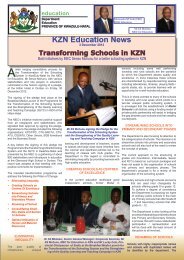P2Exam - Sci-Bono Discovery Centre
P2Exam - Sci-Bono Discovery Centre
P2Exam - Sci-Bono Discovery Centre
You also want an ePaper? Increase the reach of your titles
YUMPU automatically turns print PDFs into web optimized ePapers that Google loves.
NATIONAL<br />
SENIOR CERTIFICATE<br />
GRADE 12<br />
LIFE SCIENCES P2<br />
NOVEMBER 2010<br />
MARKS: 150<br />
TIME: 2½ hours<br />
This question paper consists of 14 pages.<br />
Copyright reserved<br />
Please turn over
Life <strong>Sci</strong>ences/P2 2 DBE/November 2010<br />
NSC<br />
INSTRUCTIONS AND INFORMATION<br />
Read the following instructions carefully before answering the questions.<br />
1.<br />
2.<br />
3.<br />
4.<br />
5.<br />
6.<br />
7.<br />
8.<br />
9.<br />
10.<br />
11.<br />
Answer ALL the questions.<br />
Write ALL the answers in your ANSWER BOOK.<br />
Start the answers to each question at the top of a NEW page.<br />
Number the answers correctly according to the numbering system used in this<br />
question paper.<br />
Present your answers according to the instructions at each question.<br />
Do ALL drawings in pencil and label them in blue or black ink.<br />
Draw diagrams or flow charts only when asked to do so.<br />
The diagrams in this question paper are NOT all drawn to scale.<br />
Do NOT use graph paper.<br />
You may use a non-programmable calculator, a protractor and a compass.<br />
Write neatly and legibly.<br />
Copyright reserved<br />
Please turn over
Life <strong>Sci</strong>ences/P2 3 DBE/November 2010<br />
NSC<br />
SECTION A<br />
QUESTION 1<br />
1.1 Various options are provided as possible answers to the following questions.<br />
Choose the correct answer and write only the letter (A – D) next to the<br />
question number (1.1.1 – 1.1.5) in your ANSWER BOOK, for example<br />
1.1.6 D.<br />
1.1.1 Which ONE of the following refers to small genetic changes within<br />
a species?<br />
A<br />
B<br />
C<br />
D<br />
Macro-evolution<br />
Micro-evolution<br />
Natural selection<br />
Artificial selection<br />
1.1.2 Which of the following are sources of phenotypic variation?<br />
(i) Random fertilisation<br />
(ii) Crossing over<br />
(iii) Random assortment of chromosomes in Metaphase 1<br />
(iv) Mutation<br />
A<br />
B<br />
C<br />
D<br />
(i), (ii), (iii) and (iv)<br />
(i), (ii) and (iv)<br />
(i), (ii) and (iii)<br />
(ii), (iii) and (iv)<br />
1.1.3 The name of the one big mass of land, that all the present<br />
continents originated from, is …<br />
A<br />
B<br />
C<br />
D<br />
Laurasia.<br />
Gondwanaland.<br />
Antarctica.<br />
Pangaea.<br />
1.1.4 Most scientists agree that … mass extinctions occurred in the<br />
history of life on earth.<br />
A<br />
B<br />
C<br />
D<br />
5<br />
7<br />
3<br />
8<br />
1.1.5 The study of fossils is called ...<br />
A<br />
B<br />
C<br />
D<br />
anthropology.<br />
ecology.<br />
palaeontology.<br />
geology.<br />
(5 x 2) (10)<br />
Copyright reserved<br />
Please turn over
Life <strong>Sci</strong>ences/P2 4 DBE/November 2010<br />
NSC<br />
1.2 Give the correct biological term for each of the following descriptions. Write<br />
only the term next to the question number (1.2.1 – 1.2.6) in your ANSWER<br />
BOOK.<br />
1.2.1<br />
1.2.2<br />
1.2.3<br />
1.2.4<br />
1.2.5<br />
1.2.6<br />
Reproduction between closely-related individuals of the same<br />
species<br />
Organisms that are able to interbreed and produce fertile offspring<br />
Dating fossils by measuring atomic decay<br />
A diagrammatic representation of possible ancestral relationships<br />
between species<br />
The taxonomic order to which monkeys, apes and humans belong<br />
The process which results in all the individuals of a particular<br />
species dying out (6)<br />
1.3 Indicate whether each of the statements in COLUMN I applies to A ONLY,<br />
B ONLY, BOTH A AND B, or NONE of the items in COLUMN II. Write<br />
A only, B only, both A and B, or none next to the question number<br />
(1.3.1 – 1.3.6) in your ANSWER BOOK.<br />
COLUMN I<br />
1.3.1 Fossil(s) of Australopithecus found in<br />
South Africa<br />
1.3.2 Similarities between Homo sapiens and<br />
apes<br />
1.3.3 Evidence from comparative embryology<br />
supporting the theory of evolution<br />
COLUMN II<br />
A: Mrs Ples<br />
B: Lucy<br />
A: Opposable thumb<br />
B: Two mammary glands<br />
A: Similar sequence of genes<br />
B: Presence of embryonic gill<br />
slits<br />
A: Biogeography<br />
B: Archaeology<br />
1.3.4 Study of ancient humans and their<br />
cultural activities<br />
1.3.5 Possible cause(s) of mass extinctions A: Volcanic eruptions<br />
B: Freezing of parts of the<br />
earth<br />
1.3.6 Mutation(s) that influence(s) biodiversity A: Neutral<br />
B: Lethal<br />
(6 x 2) (12)<br />
Copyright reserved<br />
Please turn over
Life <strong>Sci</strong>ences/P2 5 DBE/November 2010<br />
NSC<br />
1.4 Study the basic plans of the forelimbs of two different vertebrates shown<br />
below.<br />
Humerus<br />
A<br />
B<br />
Radius<br />
Ulna<br />
Carpals<br />
Metacarpals<br />
and<br />
phalanges<br />
Bat<br />
Thin skin<br />
Human<br />
Basic plans of forelimbs of two different vertebrates<br />
1.4.1<br />
1.4.2<br />
1.4.3<br />
1.4.4<br />
Are the above forelimbs homologous or analogous structures?<br />
Explain your answer to QUESTION 1.4.1.<br />
Using the labels on the forelimb of a human as a guide, give the<br />
names of the letters A and B.<br />
State TWO ways in which the forelimb of the bat is adapted for<br />
flying.<br />
(1)<br />
(2)<br />
(2)<br />
(2)<br />
(7)<br />
Copyright reserved<br />
Please turn over
Life <strong>Sci</strong>ences/P2 6 DBE/November 2010<br />
NSC<br />
1.5 The diagram below represents a geological timescale with the distribution of<br />
different organisms. The time axis is NOT drawn to scale.<br />
Flowering plants<br />
Vascular plants<br />
Birds<br />
Mammals<br />
Dinosaurs<br />
Reptiles<br />
Amphibians<br />
Bony fish<br />
Multicellular<br />
organisms<br />
Green algae<br />
Photosynthetic<br />
bacteria<br />
Anaerobic<br />
bacteria<br />
Million<br />
years ago<br />
4500<br />
700<br />
570<br />
500<br />
430<br />
400<br />
350<br />
270<br />
230<br />
180<br />
135<br />
65<br />
1.5<br />
Period<br />
Archaeozoic<br />
Cambrian<br />
Ordovician<br />
Silurian<br />
Devonian<br />
Carboniferous<br />
Permian<br />
Triassic<br />
Jurassic<br />
Cretaceous<br />
Tertiary<br />
Quaternary<br />
Era Pre-Cambrian Palaeozoic Mesozoic Cenozoic<br />
1.5.1<br />
1.5.2<br />
1.5.3<br />
1.5.4<br />
How many million years ago did the mammals first appear?<br />
In which era did the flowering plants first appear?<br />
How many years ago did the dinosaurs become extinct?<br />
Give ONE reason why anaerobic bacteria appeared before<br />
photosynthetic bacteria.<br />
(1)<br />
(1)<br />
(2)<br />
(2)<br />
(6)<br />
Copyright reserved<br />
Please turn over
Life <strong>Sci</strong>ences/P2 7 DBE/November 2010<br />
NSC<br />
1.6 The graph below shows the percentages of various types of waste found on<br />
the grounds of a school.<br />
60<br />
Amount of waste (%)<br />
50<br />
40<br />
30<br />
20<br />
10<br />
0<br />
Paper<br />
Plastic<br />
Organic<br />
matter<br />
Aluminium<br />
cans<br />
Glass<br />
bottles<br />
Type of waste<br />
1.6.1<br />
1.6.2<br />
Draw a table to illustrate the percentages of waste shown in the<br />
graph above.<br />
The school wants to manage the large amount of waste generated<br />
on a daily basis. They decide to recycle the waste.<br />
(5)<br />
(a)<br />
(b)<br />
Define recycling.<br />
Give TWO reasons why the recycling of waste is<br />
advantageous.<br />
(2)<br />
(2)<br />
(9)<br />
TOTAL SECTION A: 50<br />
Copyright reserved<br />
Please turn over
Life <strong>Sci</strong>ences/P2 8 DBE/November 2010<br />
NSC<br />
SECTION B<br />
QUESTION 2<br />
2.1 The table below shows how the yield of grass varies when different amounts<br />
of nitrate fertiliser are added to the crop.<br />
Amount of nitrate fertiliser<br />
added to crop<br />
(kg/hectare)<br />
Yield of grass<br />
(100 kg/hectare)<br />
0 8<br />
225 14<br />
425 18<br />
650 20<br />
700 20<br />
750 19<br />
2.1.1<br />
2.1.2<br />
2.1.3<br />
2.1.4<br />
2.1.5<br />
2.1.6<br />
Give ONE reason why farmers use fertiliser.<br />
What was the yield (100 kg/hectare) of grass when 225 kg of<br />
nitrate fertiliser was added?<br />
Use the table to determine the minimum amount of fertiliser that<br />
has to be added to the grass crop in order to achieve maximum<br />
yield.<br />
Describe the relationship between the amount of fertiliser added<br />
and the yield of grass.<br />
Explain why fertilisers should not be added to the soil immediately<br />
before and during the rainy season.<br />
Describe the effect of the excessive use of nitrate fertilisers on<br />
rivers, dams and lakes.<br />
(1)<br />
(1)<br />
(2)<br />
(3)<br />
(2)<br />
(3)<br />
(12)<br />
Copyright reserved<br />
Please turn over
Life <strong>Sci</strong>ences/P2 9 DBE/November 2010<br />
NSC<br />
2.2 A group of learners performed the following investigation to measure the<br />
presence of particles which cause pollution in the air in their town.<br />
The following procedure was followed:<br />
1.<br />
Three squares of 1 cm 2 were drawn on each of three glass microscope<br />
slides, using a permanent marking pen, as shown in the diagram below.<br />
1 cm<br />
1 cm<br />
Microscope slide<br />
2.<br />
3.<br />
The other side of each microscope slide was covered with a thin layer of<br />
petroleum jelly/Vaseline.<br />
The microscope slides were placed, with the side covered with petroleum<br />
jelly/Vaseline facing up, in three different outdoor locations A, B and C,<br />
and left for one week.<br />
Location A: Central area in the town<br />
Location B: 20 km away from the centre of town<br />
Location C: A fishing spot 40 km away from the centre of town<br />
4.<br />
5.<br />
6.<br />
After a week the slides were collected and examined using a hand lens<br />
(magnification x20).<br />
The visible particles in each square were counted and recorded in a table.<br />
The average number of visible particles per square (1 cm 2 ) for each of the<br />
three locations were then calculated.<br />
. 2.2.1<br />
2.2.2<br />
2.2.3<br />
2.2.4<br />
2.2.5<br />
2.2.6<br />
Formulate a hypothesis for this investigation.<br />
State the dependent variable.<br />
Explain the purpose of the squares drawn on the microscope<br />
slides.<br />
Why were the squares drawn on the back of the microscope<br />
slides?<br />
Suggest why THREE squares were drawn on each microscope<br />
slide and not one.<br />
Name THREE ways in which the validity of the investigation can be<br />
improved. .<br />
(3)<br />
(1)<br />
(2)<br />
(1)<br />
(1)<br />
(3)<br />
(11)<br />
Copyright reserved<br />
Please turn over
Life <strong>Sci</strong>ences/P2 10 DBE/November 2010<br />
NSC<br />
2.3 Read the following passage on Rooibos (Aspalanthus linearis) and answer<br />
the questions that follow.<br />
The Rooibos plant is used to make herbal tea. South Africa is the only<br />
commercial grower of Rooibos plants in the world. Rooibos tea is a<br />
caffeine-free beverage with health and medicinal benefits. Some of the<br />
benefits of drinking Rooibos tea are: it has a calming effect, it helps with<br />
digestion problems and it helps with infant colic.<br />
2.3.1<br />
2.3.2<br />
2.3.3<br />
Name any TWO health benefits of Rooibos tea.<br />
Describe TWO ways in which over-exploitation of plants, such as<br />
Rooibos, impacts on life forms and the environment.<br />
Describe THREE strategies to prevent the over-exploitation of<br />
plants, such as Rooibos.<br />
(2)<br />
(2)<br />
(3)<br />
(7)<br />
[30]<br />
Copyright reserved<br />
Please turn over
Life <strong>Sci</strong>ences/P2 11 DBE/November 2010<br />
NSC<br />
QUESTION 3<br />
3.1 Read the following passage and answer the questions that follow.<br />
Thousands of wildebeest were migrating across the great plains of the<br />
Serengeti in Africa. Some of them were large, some small, some strong and<br />
some weak. Lions followed the wildebeest, catching and eating the slowest<br />
ones. Water was scarce and only the strongest were brave enough to stop to<br />
drink from the waterholes.<br />
3.1.1 Identify ONE phrase in this passage which describes variation<br />
among the wildebeest. (1)<br />
3.1.2 Explain how Darwin's idea of evolution by natural selection can be<br />
applied to this passage. (5)<br />
(6)<br />
3.2 Lamarck based his theory of evolution on two principles, ideas or 'laws'.<br />
3.2.1<br />
3.2.2<br />
Name and describe TWO principles that Lamarck used to explain<br />
how evolution took place.<br />
Give ONE reason why Lamarck's theory is NOT accepted.<br />
(6)<br />
(2)<br />
(8)<br />
Copyright reserved<br />
Please turn over
Life <strong>Sci</strong>ences/P2 12 DBE/November 2010<br />
NSC<br />
3.3 Study the diagrams below of the upper jaw, skull and the foot of two<br />
organisms A and B. The diagrams are NOT drawn to scale.<br />
Organism<br />
Upper jaw<br />
Skull<br />
(bottom view)<br />
Foot<br />
Foramen magnum<br />
A<br />
Foramen magnum<br />
B<br />
3.3.1 With regard to the drawings above:<br />
(a)<br />
(b)<br />
Tabulate TWO visible differences between the upper jaws of<br />
organisms A and B.<br />
Name ONE visible difference between the feet of organisms A<br />
and B.<br />
(5)<br />
(2)<br />
3.3.2<br />
3.3.3<br />
Which organism (A or B) is more likely to be bipedal?<br />
Give a reason for your answer to QUESTION 3.3.2.<br />
(1)<br />
(2)<br />
(10)<br />
Copyright reserved<br />
Please turn over
Life <strong>Sci</strong>ences/P2 13 DBE/November 2010<br />
NSC<br />
3.4 Study the diagrams below showing a process of evolution. DIAGRAMS 1, 2<br />
and 3 show the sequence of events that occurred in rabbit populations over<br />
many thousands of years.<br />
River<br />
1<br />
Gene flow<br />
2<br />
River<br />
Land slide<br />
Population A<br />
Population B<br />
3<br />
River<br />
No<br />
gene flow<br />
occurs<br />
Species X<br />
Species Y<br />
3.4.1<br />
3.4.2<br />
Name the evolutionary process represented by the sequence of<br />
events shown in DIAGRAMS 1, 2 and 3 above.<br />
Describe the process stated in QUESTION 3.4.1 using the<br />
diagrams above.<br />
(1)<br />
(5)<br />
(6)<br />
[30]<br />
TOTAL SECTION B: 60<br />
Copyright reserved<br />
Please turn over
Life <strong>Sci</strong>ences/P2 14 DBE/November 2010<br />
NSC<br />
SECTION C<br />
QUESTION 4<br />
4.1 Study the table below that represents the amount of carbon dioxide emissions<br />
from different countries in 2002.<br />
Countries Total annual CO 2<br />
emission in 2002<br />
(million tons CO 2 /yr)<br />
Proportion of<br />
world total (%)<br />
USA 5 673 22<br />
China 3 733 15<br />
Russian Federation 1 477 6<br />
India 1 106 5<br />
South Africa 364 2<br />
Other countries X 50<br />
Total 24 706 100<br />
[Adapted from: World Resources Institute, 2006]<br />
4.1.1 Calculate the total annual CO 2 emission in other countries (X) from<br />
the table above. Show ALL workings. (3)<br />
4.1.2 The Kyoto Protocol was drafted by the United Nations (UN) in 1997<br />
to provide a global action plan to reduce carbon dioxide emissions<br />
by the year 2012. The United States of America (USA) is not<br />
implementing the Kyoto Protocol.<br />
(a)<br />
(b)<br />
Explain the impact that this decision by the USA has on the<br />
rest of the world.<br />
If you were working for the UN, explain TWO arguments that<br />
you would use to persuade the USA to implement the Kyoto<br />
Protocol.<br />
(2)<br />
(4)<br />
4.1.3<br />
4.1.4<br />
South Africa has the highest annual emission of CO 2 in Africa.<br />
Give THREE reasons for this.<br />
Draw a pie chart to show the proportion of CO 2 emissions from the<br />
different countries, as shown in the table above. Show ALL<br />
calculations.<br />
(3)<br />
(13)<br />
(25)<br />
4.2 Explain SIX strategies to reduce the amount of air pollution entering the<br />
atmosphere from human activity.<br />
Synthesis:<br />
(12)<br />
(3)<br />
(15)<br />
NOTE:<br />
NO marks will be awarded for answers in the form of flow<br />
charts or diagrams.<br />
TOTAL SECTION C:<br />
GRAND TOTAL:<br />
40<br />
150<br />
Copyright reserved


